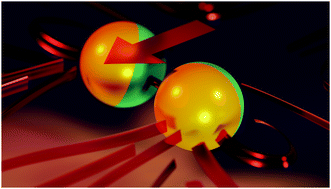Hydrodynamic interactions in squirmer dumbbells: active stress-induced alignment and locomotion†
Abstract
Hydrodynamic interactions are fundamental for the dynamics of swimming self-propelled particles. Specifically, bonds between microswimmers enforce permanent spatial proximity and, thus, enhance emergent correlations by microswimmer-specific flow fields. We employ the squirmer model to study the swimming behavior of microswimmer dumbbells by mesoscale hydrodynamic simulations, where the squirmers’ rotational motion is geometrically unrestricted. An important aspect of the applied particle-based simulation approach—the multiparticle collision dynamics method—is the intrinsic account for thermal fluctuations. We find a strong effect of active stress on the motility of dumbbells. In particular, pairs of strong pullers exhibit orders of magnitude smaller swimming efficiency than pairs of pushers. This is a consequence of the inherent thermal fluctuations in combination with the strong coupling of the squirmers’ rotational motion, which implies non-exponentially decaying auto- and cross-correlation functions of the propulsion directions, and active stress-dependent characteristic decay times. As a consequence, specific stationary-state relative alignments of the squirmer propulsion directions emerge, where pullers are preferentially aligned in an antiparallel manner along the bond vector, whereas pushers are preferentially aligned normal to the bond vector with a relative angle of approximately 60° at weak active stress, and one of the propulsion directions is aligned with the bond at strong active stress. The distinct differences between dumbbells comprised of pusher or pullers suggest means to control microswimmer assemblies for future microbot applications.



 Please wait while we load your content...
Please wait while we load your content...